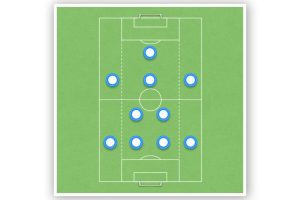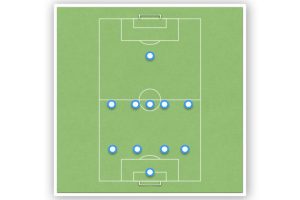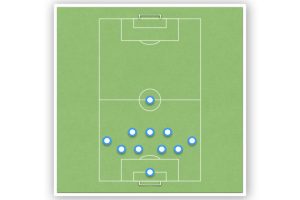Wing-Backs in 3-5-2: A Comprehensive Guide to Mastering the System
Wing-backs are an essential component of the 3-5-2 formation in soccer. This formation has become increasingly popular in recent years due to its flexibility and ability to adapt to different game situations. In this formation, the wing-backs play a crucial role in both defense and attack, making them one of the most versatile positions on the field.
Wing-backs are essentially a hybrid between a traditional full-back and a winger. They are responsible for covering the wide areas of the field, both in attack and defense. When the team is in possession of the ball, the wing-backs push forward to provide width and create attacking opportunities. When the team loses possession, they drop back to form a back five, providing extra defensive cover.
One of the strengths of the 3-5-2 formation is the flexibility it offers in terms of tactics. The wing-backs are key to this flexibility, as they can switch between defensive and attacking roles depending on the situation. This allows the team to adapt to different opponents and game situations, making it a popular choice for many coaches at both the professional and amateur levels.
What is a 3-5-2 Formation?

A 3-5-2 formation is a soccer formation that consists of three central defenders, two wing-backs (one left and one right), three central midfielders, and two central strikers. The formation is known for its flexibility and ability to switch between defense and attack quickly.
Overview
The 3-5-2 formation is a variation of the 5-3-2 formation that was popularized in the 1990s by the Italian national team. The formation is designed to provide a strong defense while maintaining a potent attacking threat.
The formation relies on the wing-backs to provide width in attack and defense. The central midfielders are responsible for controlling the midfield and providing support to the strikers. The three central defenders provide a solid core to the team and allow the wing-backs to push forward without leaving the team vulnerable to counterattacks.
History
The 3-5-2 formation was first used by the Italian national team in the 1990 World Cup. The formation proved to be successful and helped Italy reach the semi-finals of the tournament. The formation was later adopted by other teams and became popular in the 1990s and early 2000s.
The formation has since fallen out of favor with some coaches due to its perceived defensive nature. However, the formation is still used by some teams and has been successful in recent years. For example, Antonio Conte used the 3-5-2 formation to great effect during his time as manager of Juventus, winning three consecutive Serie A titles.
The Role of Wing-backs in a 3-5-2 Formation
Wing-backs play a crucial role in a 3-5-2 formation. They are responsible for providing width in both defense and attack. In this section, we will discuss the defensive and attacking responsibilities of wing-backs in a 3-5-2 formation.
Defensive Responsibilities
When the team is defending, wing-backs drop back to form a back five alongside the three center-backs. They are responsible for marking the opposition’s wide players and preventing them from crossing the ball into the box. Wing-backs also need to be aware of any runs made by opposition players and track them accordingly.
In addition to their defensive duties, wing-backs also need to be able to provide cover for their center-backs when they move out of position to make a tackle or intercept a pass. This requires excellent positional awareness and communication skills.
Attacking Responsibilities
When the team is attacking, wing-backs move forward to provide width and create space for their teammates in the middle of the pitch. They need to have good dribbling skills and be able to take on opposition players in one-on-one situations.
Wing-backs also need to be able to deliver accurate crosses into the box for their teammates to score from. They should be able to read the game well and know when to make overlapping runs to create space for their teammates.
| Defensive Responsibilities | Attacking Responsibilities |
|---|---|
| Marking opposition’s wide players | Providing width in attack |
| Preventing opposition from crossing the ball into the box | Creating space for teammates in the middle of the pitch |
| Providing cover for center-backs | Delivering accurate crosses into the box |
Overall, wing-backs play a critical role in a 3-5-2 formation. They are responsible for both defending and attacking, and need to have a wide range of skills to be effective in both areas of the pitch.
Attributes of a Good Wing-back in a 3-5-2 Formation
Physical Attributes
A good wing-back in a 3-5-2 formation needs to be physically fit and capable of contributing equally in both defense and attack. They need to have excellent stamina, speed, and agility to cover the entire flank and provide width to the team. They should also have good balance and coordination to execute quick changes of direction and movements in tight spaces.
| Physical Attributes | Examples |
|---|---|
| Stamina | Can run up and down the flank for the entire game |
| Speed | Can outrun opponents and recover quickly |
| Agility | Can change direction quickly and move in tight spaces |
| Balance | Can maintain balance while running and changing direction |
Technical Attributes
A good wing-back needs to be technically sound to execute their role within the team successfully. They should have good ball control, passing, and crossing abilities to provide quality service to the forwards. They should also have good defensive skills, such as tackling, intercepting, and marking, to stop opponents from attacking.
| Technical Attributes | Examples |
|---|---|
| Ball Control | Can receive and control the ball with both feet |
| Passing | Can pass accurately and quickly to teammates |
| Crossing | Can deliver quality crosses into the box |
| Tackling | Can win the ball back from opponents with well-timed tackles |
Tactical Attributes
A good wing-back needs to be tactically disciplined to help out in both attack and defense when required. They should have good positional sense and awareness to cover for the central defenders and midfielders when they move forward. They should also have good decision-making skills to choose the right moment to attack or defend.
| Tactical Attributes | Examples |
|---|---|
| Positional Sense | Can read the game and position themselves well to defend or attack |
| Awareness | Can anticipate opponents’ movements and react accordingly |
| Decision-making | Can make quick and effective decisions under pressure |
Training and Drills for Wing-backs in a 3-5-2 Formation
Fitness and Conditioning
Wing-backs in a 3-5-2 formation need to have excellent fitness and conditioning levels to be able to cover the entire flank throughout the game. Therefore, training sessions should focus on building endurance, speed, and agility.
Some drills that can help improve fitness and conditioning for wing-backs include:
- Interval training
- Cone drills
- Box-to-box runs
- Sprint and recovery runs
It is also important to incorporate strength training exercises to build the necessary muscle mass and prevent injuries.
Defensive Drills
Wing-backs in a 3-5-2 formation are expected to contribute to the team’s defense by tracking back and marking opposition wingers. Therefore, it is crucial to train them in defensive drills that can help improve their positioning, tackling, and marking skills.
Some drills that can help improve defensive skills for wing-backs include:
- 1v1 defending
- Defensive positioning drills
- Marking drills
- Recovery runs
It is also important to teach wing-backs how to read the game and anticipate opposition attacks so that they can intercept passes and make crucial tackles.
Attacking Drills
Wing-backs in a 3-5-2 formation are expected to contribute to the team’s attack by providing width and crossing the ball into the box. Therefore, it is crucial to train them in attacking drills that can help improve their crossing, dribbling, and shooting skills.
Some drills that can help improve attacking skills for wing-backs include:
- Crossing and finishing drills
- Dribbling and shooting drills
- Overlapping runs and passing drills
- Combination play with forwards and midfielders
It is also important to teach wing-backs how to time their runs and make overlapping runs to create space for themselves and their teammates.
Conclusion
Overall, the 3-5-2 formation can be an incredibly effective way to play soccer. It allows for a strong midfield presence and can create opportunities for fluid attacking play. However, it is not without its weaknesses, particularly in the wing-back position.
Wing-backs in the 3-5-2 formation have significant responsibilities in both attack and defense. They must be highly skilled and tactically disciplined to effectively execute their role. As such, teams utilizing this formation must have high-quality players in these positions to be successful.
| Strengths of the 3-5-2 Formation | Weaknesses of the 3-5-2 Formation |
|---|---|
| Strong midfield presence | Reliance on high-quality wing-backs |
| Fluid attacking play | Can be vulnerable to counter-attacks |
| Creates overloads in various areas of the pitch | May struggle against teams with wide attacking threats |
Ultimately, the success of the 3-5-2 formation depends on the quality of players and their ability to execute their roles effectively. Teams with strong wing-backs and a solid midfield can find great success with this formation, while those lacking in these areas may struggle.







